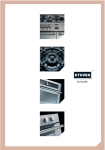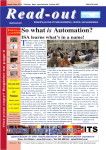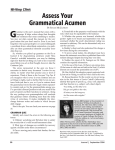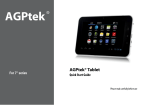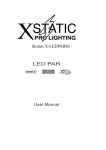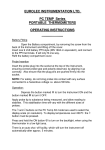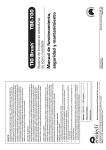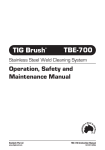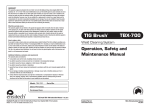Download 08 27320 00
Transcript
Our Warranty Should you need it . . . . Inside the paperwork which has come with this appliance, there is a leaflet and card explaining the terms of our extended warranty and guarantee. In order to apply for our five year guarantee, simply fill in the details on the card and post it off, this will register your appliance. Should you wish to take out extended warranty, please fill in the details on the leaflet and post this off to: PO Box 33, Springwood, Queensland,4127 If your appliance is covered by the warranty and guarantee, you will not be billed for work undertaken should your appliance be faulty, terms and conditions do apply, so please read through the literature carefully. Please ensure that you have available your appliances model number and serial number, there is a space at the back of this book for recording that information. CONTENTS Introduction . . . . . . . . . . . . . . . . . . . . . . . . . . . . . . . . . . . . . . . . . . . . . . . . . 2 Be Safe - Not Sorry. . . . . . . . . . . . . . . . . . . . . . . . . . . . . . . . . . . . . . . . . . . . 3 Using the Hob. . . . . . . . . . . . . . . . . . . . . . . . . . . . . . . . . . . . . . . . . 4 Your induction hob . . . . . . . . . . . . . . . . . . . . . . . . . . . . . . . . . . . . . . . . . . . . 4 How induction works. . . . . . . . . . . . . . . . . . . . . . . . . . . . . . . . . . . . . . . . . . . 6 How to use the induction hob cooking zones . . . . . . . . . . . . . . . . . . . . . . . . . . 7 Safety . . . . . . . . . . . . . . . . . . . . . . . . . . . . . . . . . . . . . . . . . . . . . . . . . . . . . 9 Choice of pans. . . . . . . . . . . . . . . . . . . . . . . . . . . . . . . . . . . . . . . . . . . . . . 10 Cooking with your induction hob . . . . . . . . . . . . . . . . . . . . . . . . . . . . . . . . . 12 Cooking guide . . . . . . . . . . . . . . . . . . . . . . . . . . . . . . . . . . . . . . . . . . . . . . 14 Care & cleaning . . . . . . . . . . . . . . . . . . . . . . . . . . . . . . . . . . . . . . 15 Cleaning . . . . . . . . . . . . . . . . . . . . . . . . . . . . . . . . . . . . . . . . . . . . . . . . . . 15 Care of your induction hob . . . . . . . . . . . . . . . . . . . . . . . . . . . . . . . . . . . . . 16 Troubleshooting . . . . . . . . . . . . . . . . . . . . . . . . . . . . . . . . . . . . . . 17 Installation Instructions . . . . . . . . . General information . . . . . . . . . . . . . . . Choosing your installation . . . . . . . . . . . Fitting into worktop . . . . . . . . . . . . . . . . Connect to the electricity supply . . . . . . . . . . . . . . . . . . . . . . . . . . . . . . . 18 . . . . . . . . . . . . . . . . . . . . . . . . . . . 18 . . . . . . . . . . . . . . . . . . . . . . . . . . . 19 . . . . . . . . . . . . . . . . . . . . . . . . . . . 20 . . . . . . . . . . . . . . . . . . . . . . . . . . . 22 Technical Data . . . . . . . . . . . . . . . . . . . . . . . . . . . . . . . . . . . . . . . 23 Stoves Customer Support . . . . . . . . . . . . . . . . . . . . . . . . . . . . . . . 24 Please keep this handbook for future reference or for anyone else who may use the appliance. 1 INTRODUCTION Thank you for choosing Stoves by Eurolec appliance a Environmental Protection We are committed to protecting the environment and operate an Environmental Management System. We hope the following information will help you to quickly familiarise yourself with the features of the appliance, and to use it successfully and safely. Disposal of packaging Our policy is one of constant development and improvement. Strict accuracy of illustrations and specifications is not guaranteed. Modification to design and materials may be necessary subsequent to publication. Your 1st year guarantee • All our packaging materials are recyclable and environmentally friendly. • Please help us to protect our environment by disposing of all packaging in an environmentally friendly manner. • Please contact your local authority for the nearest recycling centre. Caution: Packaging materials can pose a risk of suffocation - keep away from children. To fulfil the conditions of your guarantee, this appliance must be correctly installed and operated in accordance with these instructions, and only used for normal domestic purposes. Before use Electrical connection Please read the instructions in this handbook before using or installing this appliance. Please refer to installation instructions for electrical connection. Make sure that all packaging is removed before installation. In your own interest, and that of safety, make sure that the installation is carried out by a competent person. Before using the hob for the first time, apply a thin coating of cleaner conditioner to the hotplate glass, and polish the glass surface with a clean dry cloth. Follow the instructions given in the “Care & Cleaning” section. Disconnection of electric appliances should always be carried out by a competent person. Warning: This appliance must be earthed. 2 BE SAFE - NOT SORRY Keep children away from the vicinity of the hob when you are cooking. • Commercial simmering aids should not be used as they create excessive temperatures that can damage the surface and may cause a hazard. • The vitro-ceramic surface is very tough, but it is not unbreakable; don’t bang pans down onto it. • Pan bases which are very rough may trap and carry substances which may mark or scratch the hob. • Avoid friction; over a period of time, this may damage the pattern on the vitro-ceramic top. Cooking will be a pleasure if you follow a few rules and look after your hob. • • Use pans with a flat base which are stable in use, and avoid using any old misshapen pans or any pan which is unstable when placed on a flat surface. Never leave fat or oil unattended on an operating hotplate. • Keep all flammable materials away from the hob. • Do not place aluminium foil on the hob surface. • Nothing should ever be left lying on the hob. • When cooking, turn pan handles to a safe position, so they are out of reach of children, not overhanging the appliance and cannot be caught accidentally. • Do not store CLEANING PRODUCTS or FLAMMABLE ITEMS in the unit underneath your cooking hob. • Metallic objects such as knives, forks and spoons should not be placed on the hob surface, they are likely to get hot. • When plugging electric appliances into sockets near the hob, make sure that the cable does not come into contact with a heating zone. • Caution: Do not use the hob if the glass is cracked, as electrical parts are directly beneath. To avoid the possibility of electric shock, disconnect the appliance from the electricity and arrange a Service call. When you have finished cooking check that all hotplate controls are switched off. Do not use any part of the hob before the vitro-ceramic top has been changed. 3 USING YOUR HOB Your induction hob 600CTI 700CTI Graphics detail Graphics detail 4 USING YOUR HOB Boost ‘Power’ Function Your Induction hob Indicator (1 to 9) of power level selected for each heating zone. The illustration below shows where the power indicators and timer indicator are on your hob (shown as dotted boxes) Timer display Symbol indicating the heating zone on the hob. Adjustment of power (+ or -) for each heating zone. On/off control Hob lock sensor Timer sensor 5 USING YOUR HOB How induction works When compared with conventional cooking hobs, your induction hob is; Principle of induction • “Induction” currents instantly heat the pan*, which then passes its heat on to the food it contains. More economical - when a pan is lifted off, the zone stops heating immediately. • *Pans in enamelled steel, cast iron or stainless steel are suitable for use on an induction hob. Quicker - 3000W of power is immediately available at the heating zone. • More precise - the hob reacts immediately to your instructions. • Safer - the temperature of the glass top remains relatively low. With an induction hob, the heat necessary for cooking the food is produced directly inside the pan; the vitro-ceramic glass hardly heats up at all, as it only receives the heat from the pan placed on it. 6 USING THE HOB How to use the induction hob cooking zones The Zone Indicator (Timer) On the timer there are four lights at the corners, these correspond to you heating zones. As with the power indicators, these will flash when not selected and remain static when selected. See the programming information on the following page for more details. Switching on Look for the controls which correspond to the zone where you have put your pan. • Press the key. The power indicator shows 0, next to all the heating zone selectors and the hob is switched on. • Use the heating zone selectors to choose which zone you wish to use. Ensure that your pans are in place first. • Adjust the heating power you want using the + and - key. The Power Booster To use the power booster for rapid heating, touch the Booster sensor ‘P’, the power indicator will display a P. The booster function stops after 4 minutes automatically. While the booster is on the heating zones at the front of the hob will only reach 600W, this is to prevent over heating. After you have pressed the on/off control key, if you do not touch any sensor within 10 seconds, the instruction will be automatically cancelled. • Turning a heating zone off There are two ways to switch off the Induction hob: • Touch the ‘-’ sensor until the display shows ‘0’ • Touch the ‘+’ and ‘-’ sensors together. Adjust the power during cooking. You can adjust the heating power from 1 to 9 at any time during cooking using the + and - keys. Note: Please note: The hob is equipped with 4 residual heat indicators. The display shows ‘H’ if the temperature of that heating zone exceeds 60˚C. Next to the power indicator is a ‘.’ this will flash when a zone has not been selected. When the ‘.’ is static a zone has been selected and the power levels can be adjusted. This prevents the risk of burning. Although there may be slight differences between both types of hob i.e. graphics, the principles of operation remain the same. You must make sure you have selected a zone before you start, otherwise you cannot make any adjustments. 7 USING THE HOB Programming a cooking The warming zone duration 700CTI only select the timer key to access the programming function. The corresponding indicator lights flashes. The 700CTI hob incorporates a warming zone which is ideal for keeping food items on an extremely low heat to prevent boiling over or burning. Press the ‘+’ key to display the required cooking duration (max 99 mins) Press the timer key to confirm the programming operation. To operate the warming zone touch the warming zone symbol. The timer starts counting down immediately. An audio signal sounds at the end of the cooking time and the heating zone switches off. Press the off key to switch off the appliance. The display above will show ‘1’ to indicate that the zone is active. Multiple programming Place you pan on top. It is possible to programme more than one heating zone at a time. Simply repeat the above steps on whichever zones you wish to use. To switch off the warming zone, simply touch the warming zone symbol again. The display will show ‘H’ alerting you that it may be hot to touch with any residual heat. Alternatively, the zone can be turned off when the power symbol is touched to turn off the hob. Note: The indicator light will remain lit once the duration has been confirmed. Once a further zone is programmed and confirmed, that will remain lit and the indicator light for the zone programmed first will begin to flash. This is not an error, continue with cooking, or programming. To see how long a zone has, select the zone you wish to look at and touch the sensor. The indicator light will remain lit and the time remaining will show. An audio signal will sound once the various times have counted down and the zone will switch itself off. 8 USING THE HOB Detection of an object or a pan on the heating zone Safety Regularly check that there is nothing (cloth, paper, etc) which might block the air inlet underneath your hob (see section “Installation Instructions”). A small object - such as a fork, a spoon or even a ring - placed on a hob cooking zone on its own is not detected as a pan. Hob Lock The display flashes and no heating power is supplied. For your safety this hob has fitted with a hob lock. To activate touch the sensor marked: The security system acts in the same way when it detects a pan which is not suitable for use on an induction hob. If you are fitted with a pacemaker or an active implant To unlock, simply press the senor again. The functions of the hob comply with the applicable standards on electromagnetic interference Your induction cooking hob thus complies fully with the statutory requirements (Directive 89/336/EEC). It is designed to not interfere with the functioning of other electrical equipment as long as these also comply with the same regulations. Audio Warning An audio signal sounds when your appliance detects a problem on the control panel, such as: An object (pan, cover, etc) placed on the control panel for more than ten seconds. Your induction hob generates magnetic fields in its immediate vicinity. A spill on the control panel Prolonged pressure on the control panel. So that there is no interference between your cooking hob and a pacemaker, the pacemaker must be designed in compliance with the appropriate regulations. The hob will also switch itself off. To reset, simply touch the power on sensor. In this respect we can only guarantee the compliance of our own product. You can ask the manufacturer or your doctor about the compliance or any incompatibilities of your pacemaker. 9 USING THE HOB • Choice of pans The most suitable pans for induction cooking are listed below. Most stainless steel pans are suitable for induction cooking (saucepan, pot, frying pan, chip pan, etc). Note : A pan with a base not absolutely flat may still be suitable, as long as it is not too distorted. Some stainless steel pans have copper bases which are usually not suitable. Choose a pan bearing the logo on its base or packaging to be sure that it is perfectly suitable for use on your hob under normal conditions of use. • You can also find a range of pans suitable for induction cooking by looking in quality kitchen shops. Look for the wording and symbol “suitable for induction”. with a Incompatible pans Glass, ceramic or earthenware pans, aluminium pans (unless they have a special base), copper pans, some nonmagnetic steel pans. Pans in enamelled steel, with or without non-stick coating For example; cooking pot, chip pan, frying pan, meat grill pan, etc. • Aluminium pans special base Choose pans with a thick base, as this ensures more even cooking (the heat is more evenly distributed). You probably already have some suitable pans: • Stainless steel pans suitable for induction The pan test Because of its leading-edge technology, your induction hob is able to “recognise” most pans. Cast iron pans To avoid the risk of scratching the glass top of your hob, use pans with an enamelled base, or avoid sliding the pan across the glass surface. Place your pan on a heating zone on power setting 4; 10 • If the indicator stays fixed, your pan is compatible. • If the indicator flashes, the pan cannot be used for induction cooking. USING THE HOB Advice for selecting suitable pans • When buying new pans, always refer to the pan manufacturer’s guidelines. • For best results and energy efficiency it is important to use flat bottomed pans of the correct type. • Always use pans which are large enough to prevent spillage, especially for deep frying, making jam or cooking with sugar or syrup based substances. • • Looking after your pans Stainless steel pans Abrasive products should never be used on stainless steel pans. They should be washed with a sponge. APPEARANCE OF WHITE MARKS: Cause: salt added to cold water. Solution: add salt when the water boils. APPEARANCE Trivets, round based woks, heat diffuser pads and over-sized pans are not recommended. OF SPECKS: Cause: hard water. Solution: boil diluted vinegar in the pan, then rinse and dry. Avoid using double pans, or old misshapen pans which are unstable and dangerous. BURNED FOOD STUCK TO THE BOTTOM OF THE PAN: Cause: temperature too high. Solution: leave the pan to soak, or boil soapy water in it (1 part washing-up liquid to 10 parts of water). Cast iron pans Cast iron pans should only be cleaned with a sponge or nylon brush or a nonabrasive washing-up product. Wipe with a little vinegar to regain the pan’s shine. This also works for colour-enamelled cast iron. For “matt black” items, use vinegar instead of bleach, then oil carefully and wipe with kitchen roll. 11 USING THE HOB Cooking with your induction hob • Do not leave an empty pan on a heating zone. • Pans should be placed in the centre of the heating zone. • Never heat up a sealed tin of food, as it may explode. • After use, please ensure that you switch the appliance off. Do not rely on the pan detector. • When you use a pan with a nonstick coating (eg; Teflon) with little or no fat, heat the pan first for a moment on setting 6 or 7. • We recommend that you do not put metal cooking utensils, cutlery, knives or other metal objects on the hob, as they could become hot if they are near a cooking area which is in use. • It is perfectly possible to use a pan with a smaller diameter than that of the ring marked on the vitro-ceramic glass (note that we recommend a minimum 5” pan base diameter); there will be no loss of energy as is the case with conventional cookers (electricity and gas). • Nothing should ever be left lying on the hob. • Do not use the hotplate surface for storage. • Lift pans onto and off the hob, rather than sliding them across the surface, to avoid marks and scratches. • As soon as the water boils, turn the cooking zones down to a lower setting; this will help prevent pans boiling over. • Do not use the vitro-ceramic glass surface as a work surface or chopping board, as it will damage it, and if any plastic utensils come into contact with a warm hob, they may melt onto it. • As pans are on a smooth surface, they will move easily if knocked accidentally; turning pan handles so they are not overhanging the edge of the hob, will help prevent this happening and keep them out of the reach of children. • Be careful when cooking foods in salted water, or foods containing large amounts of sugar or syrup, if they are spilt onto hot areas of the hob they may damage the glass. Wipe any spillage as soon as possible. Use pans which are large enough to avoid overflows onto the vitroceramic glass hob surface. 12 USING THE HOB Cooking tips Aluminium foil • When cooking, never use kitchen foil and never put items wrapped in kitchen foil straight onto the hob. Green vegetables (spinach, broccoli, sorrel, etc) or vegetables rich in sulphur compounds (cabbage, onions, etc) should be cooked without a lid in plenty of boiling water; they will cook more quickly, and will keep their green colour (some vegetables only), vitamin and minerals content. • Pasta, rice, cereals, etc absorb water during cooking and increase in volume; cook them in plenty of boiling salted water in order to dilute the starch they contain. • Make sure you use a sufficiently large pan to avoid boiling over; the temperature setting may need to be reduced to maintain a simmer. • Mushrooms should be poached in a small quantity of boiling water, with salt, butter and lemon juice. • When liquids boil, reduce the control setting to maintain a simmer. • Vegetables will cook quicker if chopped in smaller pieces. The aluminium kitchen foil may melt and do irreparable damage to your appliance. 13 USING THE HOB maximum positions and should only be used for deep frying and bringing up to the boil quickly. Cooking guide For best cooking results, follow the examples in the guide below, bearing in mind that settings 8 and 9 are Preparations Very fast, Frying 9 8 Fast 7 Medium 6 Soups THIN SOUPS THICK SOUPS Slow 5 4 Simmering, Re-heating 3 Keeping warm 2 1 5 4 Fish COURT-BOUILLON DEEP FRIED 7 5 Sauces THICK, FLOUR-BASED SAUCES BUTTERY SAUCES CONTAINING EGGS (Béarnaise, Hollandaise) 3 2 Vegetables SPINACH PULSES BOILED POTATOES CARROTS SAUTÉ POTATOES FROZEN VEGETABLES 6 5 3 4 6 6 5 5 4 Meat THIN CUTS OF MEAT 9 FRIED STEAK 8 GRILLED MEAT (using cast-iron grill pan) 9 Deep frying FROZEN CHIPS FRESH CHIPS 9 9 Other types of cooking PRESSURE COOKER 9 STEWED FRUIT PANCAKES 9 8 CUSTARD TO MELT CHOCOLATE JAM MILK FRIED EGGS PASTA 9 RE-HEATING GLASS JARS OF BABY FOOD (in a pan of water) STEWS RICE PUDDING 5 (ONCE PRESSURE HAS BUILT UP) 4 2 1 4 7 7 4 3 4 2 KEEPING FOOD WARM 1 14 CARE & CLEANING Caution: Any cleaning agent used incorrectly may damage the hob. Cleaning Some cooking operations generate a considerable amount of grease. This, combined with spillage, can become a hazard if allowed to accumulate on the hob through lack of cleaning. In extreme cases this may amount to misuse of the appliance and could invalidate your guarantee. Do not use abrasive powder cleaners, soap filled pads, metal wire, bleaches, abrasive-backed sponge, bath stain removers, or chemical oven cleaners; all these product types will damage the vitro-ceramic glass. Never clean your hob while it is on. Set all the controls to 0 first. Use non-abrasive cream cleaners, with an ordinary sponge or special sponge suitable for delicate items. Do not use caustic pastes, abrasive cleaning powders, coarse wire wool, products containing bleach or any hard implements, as they will damage the surfaces. The following recommendations will help to keep the vitro-ceramic glass surface bright and clean; All user accessible parts of the hob can be safely cleaned with a cloth wrung out in hot soapy water. Please note: Do not steam clean any part of your hob 15 • Use a dampened paper towel or clean damp cloth to apply a small dab of cleaner conditioner to clean each heating area. • Use another paper towel or a clean dry soft cloth to wipe dry, and then polish the whole glass surface. • To remove any stubborn marks or heavy soiling, a non scratching, mild cream cleaner may be used. Alternatively, a “ceramic hob scraper” may be used. CARE & CLEANING Care of your induction hob Discolouration of the hob Before using the hob for the first time, apply a thin coating of cleaner conditioner to the vitro-ceramic glass, and polish the surface with a clean cloth. Do not use a dishcloth or dish sponge to wipe the hob - this can leave a film of detergent on the surface which will discolour the hob next time a heating area is used. Clean cloths kept for the cleaning of the hob can be used. The conditioner gives a protective covering to the vitro-ceramic glass which not only makes the hob easier to clean, but also ensures that you will gain maximum life out of this product. Do not use too much cleaner conditioner - only a thin coating is required, any excess may burn on and discolour the hob when it is next in use. Occasional use will help prevent the build up of mineral deposits which can cause discolouration of the hob surface. If persistent stains or marks remain on the vitro-ceramic glass surface, it can be cleaned using a mild cream cleaner, or a ceramic hob scraper. This will also remove any accumulated salts or minerals before they have an opportunity to discolour the vitro-ceramic glass. Wipe clean with a damp paper towel or clean damp cloth and re-apply cleaner conditioner. 16 TROUBLESHOOTING The hob produces a smell the first few times it is used • Once a cooking zone has been turned on, the indicators on the panel keep flashing !! Heat a pan full of water on each zone for half an hour. • Pans make a noise during cooking!! • The hob won’t work. indicators don't come on This is caused by vibration due to the passage of energy from the hob to the pan. • On a high setting this is quite normal for certain types of saucepan. It will not damage the hob. • The electricity supply is not reaching the appliance (faulty supply or connection); The electronic circuit is not working properly; Call Stoves Customer Support, or your supplier. This is caused by the distribution of power between two heating zones on the same side of the hob. When it is turned on, the appliance cuts out The top of the hob is always warm (even when not in use) • The Check the fuses and the cut-out switch. The hob makes a slight clicking sound • The pan you are using is not suitable for induction cooking or is less than 12cm (5”) in diameter. • The hob connection is faulty. The electronic part of the hob, like any other electronic equipment (TV, transformer, etc), becomes warm. Check the connection and check that the connection complies with the appropriate standards. The fan keeps working for a few minutes after the hob has been turned off When it is turned on, only one side of the hob works • • To cool down the electronics. The hob connection is faulty. Check the connection and check that the connection complies with the appropriate standards. 17 INSTALLATION INSTRUCTIONS General information Choosing your installation INSTALLATION SHOULD ONLY BE CARRIED OUT BY A QUALIFIED INSTALLER OR ENGINEER. 1. Over a unit with a door or drawer. 2. Above an oven. Please keep to the following points most carefully; • The hob should not be fitted above a washing machine, a fridge or a freezer. • Wall surfaces above the work surface and in the immediate vicinity of the cooking hob must be heat resistant. • • In all cases your induction hob needs to be well ventilated. Make sure that the air inlet through the ventilator grid underneath the hob are never blocked. 1. Installing the hob over a unit with a drawer or door Air outlet is underneath work surface. Laminated surfaces and the adhesive used for fixing them must be heat resistant in order to avoid any damage. If necessary, remove the front crosspiece of the unit. Suitable protection to prevent obstruction of the air inlet to the fans must be provided. The space for air circulation, located underneath and at the back of the hob improves its reliability by ensuring that it will cool down, however it has been fitted in. We recommend that you install this appliance in a work top which is a minimum 38mm deep. The hob can be fitted into a a work top less than 38mm deep, but the 9mm gap between hob base and appliance must be maintained 18 INSTALLATION INSTRUCTIONS Installing the hob above an oven Installing the hob above a Stoves 720mm twin cavity oven In the even of repeated operation of the thermal protection devices, you can install an insulation kit between the oven and the hob (available from Stoves Customer Support or your local supplier). A minimum 9mm gap must be maintained between the oven top and the base of the hotplate. . The appliance MUST be fitted on the runner kit provided. It is not suitable for shelf type installation if the plinth line is to be maintained. With this configuration, the oven can be fitted in the unit in the lower position only. Ovens other than Stoves Refer to the manufacturer’s instructions for clearances above the oven. Installing the hob above a Stoves 600mm single cavity oven We recommend a 9mm gap between hob and appliance, should the work surface be less than 38mm deep. A minimum 9mm gap must be maintained between the oven top and the base of the hotplate. Installing the hob above a pyrolytic oven If installing the hob above a pyrolytic oven, additional provision for air circulation / ventilation may be required. Due to the exessive temperatures attained during pyrolosis, using the hob at the same time may cause the thermal safety device within the hob to operate. 19 INSTALLATION INSTRUCTIONS - 600CTI Minimum clearance above the hob Fitting into worktop • Cut a hole in the work surface to the required size. 300mm A clearance of at least 40mm should be maintained between the cutout and any rear or side wall. • The cooking hob should be fitted into a worktop which is least 40mm thick. The worktop must be of heat-resistant material or covered with heat-resistant material. • Protecting the cut-out; Important: So that cooking utensils can be used easily, there should be no unit or vertical surface within 300mm of the cooking hob. The types of chipboard used for work surfaces swell relatively quickly in contact with humidity. Apply a special varnish or adhesive to the cut edge to protect it from steam or condensation which may form under the work surface under the hob. 20 INSTALLATION INSTRUCTIONS - 700CTI Minimum clearance above the hob Fitting into worktop • Cut a hole in the work surface to the required size. 300mm A clearance of at least 40mm should be maintained between the cutout and any rear or side wall. • The cooking hob should be fitted into a worktop which is least 40mm thick. The worktop must be of heat-resistant material or covered with heat-resistant material. • Protecting the cut-out; Important: So that cooking utensils can be used easily, there should be no unit or vertical surface within 300mm of the cooking hob. The types of chipboard used for work surfaces swell relatively quickly in contact with humidity. Apply a special varnish or adhesive to the cut edge to protect it from steam or condensation which may form under the work surface under the hob. 21 INSTALLATION INSTRUCTIONS Connect to the electricity supply Secure hob to worktop Warning: This appliance must be earthed. After connecting to the electrical supply, place the hob in the cutout and secure in place using the four brackets and screws provided. The hob must be installed by a competent electrician, using a double pole control unit of 32 ampere minimum capacity, with 3mm minimum contact separation at all poles. 40mm seal worktop hob We recommend that the appliance is connected by a qualified electrician who will comply with the AS/NZS 3000:2000 electrical installation and local regulations. 1. Connection should be made with minimum 4.0mm2 twin & earth cable. 30mm seal worktop 4. First strip the wires, then push the cable through the cable clamp in the terminal block cover. hob 5. Connect the cable to the terminal block and tighten the cable clamp screw (see diagram). Live The brackets should be orientated to suit the worktop thickness as shown, then inserted into the four slots (two on the front edge and two on the rear) and screwed into the underside of the worktop using the woodscrews provided. 1 (Red or Brown) 2 3 Neutral 4 (Black or Blue) 5 Earth (Green / Yellow or sleeving) The screws should be tightened just sufficiently to secure the hob to the worktop, but not overtightened as this may damage the glass top. Cable clamp Live 1 , Neutral 3 , Earth If the base of the hob is accessible after installation, then a partition must be fitted 20mm below the base to prevent access. . 6. Close the terminal box, ensuring that the cover is engaged on the locking tabs. 22 TECHNICAL DATA Power supply 220 - 240V ~ 50Hz Country of destination AUS Maximum load at 230V 600CTI - 7200W 700CTI - 7310W Weight 13.5kg approx 600CTI 1800W 1800W 1200W 1200W 700CTI 1800W 1800W 110W 1200W 1200W 23 ISSUE A 600 CTI - AU S TOVES Wiring colour code: Bk - Black, Bn - Brown, Bu - Blue, Gn - Green, Or - Orange, R - Red, W - Wh L Or Gn INDUCTION ELEMENT INDUCTION ELEMENT N Bk 219 218 475 218 219 Gn Bk N L 218 TERMINAL BLOCK Gn Bk Or 219 475 Gn L INDUCTION ELEMENT INDUCTION ELEMENT N Or 26 Or 475 218 219 475 Bk 06/07/06 ISSUE A 700CTI - AU S TOVES Wiring colour code: Bk - Black, Bn - Brown, Bu - Blue, Gn - Green, Or - Orange, R - Red, W - Wh L 475 Gn INDUCTION ELEMENT INDUCTION ELEMENT N Bk Or 219 218 218 Gn W N L 204 Bk Or 219 Gn TERMINAL BLOCK W W 218 475 INDUCTION ELEMENT L INDUCTION ELEMENT Or Gn 475 219 N 218 Bk 27 219 Bk 475 Or W W W 204 06/07/06 NOTES 28 NOTES 29 NOTES 30 Service Record Please record your model number and serial number in the space below. Where are my model and serial numbers? Freestanding HL appliances: Freestanding appliances: Built in oven: Hobs: base of storage drawer front frame near oven cavity front frame near oven cavity base plate of the hob Having these numbers to hand will help us to help you, quickly and more efficiently. When contacting us, please use the Customer Care number on the back cover of this book. Model Number Serial Number Date of purchase Installer stamp / Printed name Date of installation Place of purchase: Date Part(s) replaced Engineers Stamp/ Printed Name Contact Us For Service information please call: Tel: 1800 033700 Calling for a service If you should experience any problems with your cooker please contact your retailer or place of purchase. Important note: Service work is to be conducted by authorised persons only. It is also adviseable that your cooker is checked regularly and maintained in good condition. An annual maintenance is recommended. Always check the instruction book before calling a service agent to make sure you have not missed anything. Before you contact a service agent, make sure that you have the following information to hand: Model Number Serial Number Date or Purchase Postcode Proudly distributed by Eurolec. Head Office address: 27 Watland Street, Springwood, Queensland 4127 08 27320 00 © 07.2006 Electric Induction Hob Model Names: 600CTI, 700CTI
































